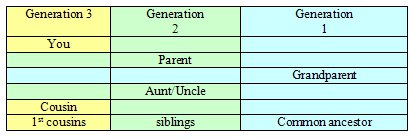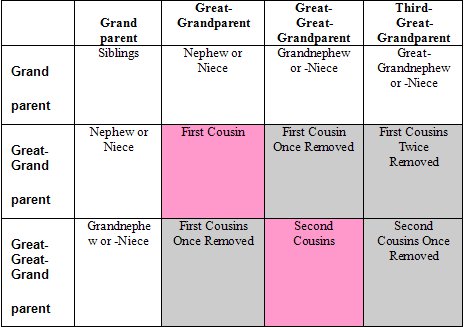Family Tree: Understanding Cousin Relationships
June 4, 2012 by ramona
Filed under Articles, Genealogy Reports and Charts, Introduction to Genealogy, Latest News
 Relationship charts are a great tool for understanding your family tree…when you know how to use them. However, for the genealogy beginner they can be a little confusing.
Relationship charts are a great tool for understanding your family tree…when you know how to use them. However, for the genealogy beginner they can be a little confusing.
The purpose of a relationship chart is to help you identify the first common ancestor shared between you and a non-immediate family member such as a cousin.
For example, by looking at the first two rows of a family relationship chart you can see that the first common ancestor you share with a sibling is a parent, you share a grand parent with a niece or nephew and a great-grandparent with a great-niece or nephew.

This all seems straightforward until you start going down the chart and run into “cousins removed”. So what is a cousin “removed”? The easiest way to understand this is to think of it in terms of how many generations there are between first and second cousins and then go one-step further.
A first cousin is the child of an uncle or aunt and the first common ancestor you share is a grand parent.

Second cousins are separated by another generation. Simply put second cousins are the children of first cousins. Both children are separated by two generations from their common ancestor.

To understand cousins once removed lets go that extra step. Your cousin once removed is a cousin of your parent.
- The common ancestor of you and your first cousin once removed are your great-grandparents
- There are two generations separating you from your great-grandparents (your parents and your grandparents)
- There is one generation separating your first cousin once removed from your great-grandparents (your great-uncle/aunt).
Since your parents cousin (your first cousin once removed) is one generation closer to your common ancestor there is one generation or “degree” of difference between the relationships you and the “cousin” share with the common ancestor.

One rule to help remember “removed” relationships are that there is always an unequal distance (grey squares) between the “removed” cousins and the common ancestor, while cousins that are not removed will have an equal distance (pink squares) between the common ancestor.

Did you know that in over ten generations you could have well over two thousand direct line ancestors?
Two parents + four grandparents + eight great-grandparents + sixteen great-great-grandparents + thirty two great-great-great-grandparents + sixty four great-great-great-great-grandparents + one hundred twenty eight great-great-great-great-great-grandparents + two hundred fifty six great-great-great-great-great-great-grandparents + five hundred twelve great-great-great-great-great-great-great-grandparents + 1,024 great-great-great-great-great-great-great-great-grandparents (2+4+6+8+16+32+64+128+512+1024) = 2046 direct ancestors in ten generations.
Sign up today for a Free Trial membership with Genealogy Beginner and you will receive a Family Relationship Chart as part of your Family Tree Starter Kit.
